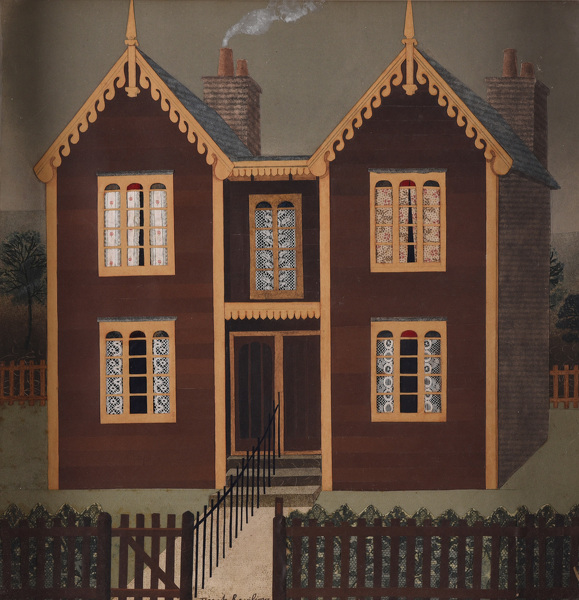

 Hover over the painting to magnify (there may be an initial delay while the magnified image is loaded)
Hover over the painting to magnify (there may be an initial delay while the magnified image is loaded)Tirzah Garwood-Ravilious (1908–1951):
Semi-detached Villas, 1945
Framed (ref: 7044)
Signed
See all works by Tirzah Garwood-Ravilious collage/photomontage farms/domestic animals houses 1.Master Designs 49 pictures Fifty Works by Fifty British Women Artists 1900 - 1950 Garden Museum RCAGardenMusuem Rediscovering Women Artist WOMEN Works for Paris
Provenance: Kenneth Rowntree; thence by descent; private collection
Literature: Hornet & Wild Rose, The Art of Tirzah Garwood, by Anne Ullmann, The Fleece Press, 2020
During her recovery from a mastectomy for primary cancer and closely followed by the death of my father, the artist Eric Ravilious, in 1942, my mother, Tirzah, wrote an entertainingly direct and perceptive autobiography of their life together. She was thirty-four and the mother of three young children. As a student, she had excelled as a wood engraver. She now rediscovered the creativity that had lain virtually dormant throughout her married life. She began painting in oils, but also produced a series of captivating images of local Essex houses and shop fronts, (1944–1949). She soon developed her own distinctive style, where each one was lovingly recorded with a mixture of print and collage which she assembled and sometimes constructed into a 3D model in a shallow box frame. This early example, Semi-detached Villas, has the barge boarding and paint work picked out in ochre against the dark brown house, and the deep wooden frame painted white gives an added spatial dimension to the image set back behind the glass. A quantity of sketches of architectural details suggest that all her subjects were from real life. The key to the success of Tirzah’s series of houses is that as a painter might set about portraying a human face, so Tirzah, by isolating the subject and stressing the features that most interest her, brings out the individuality that had originally attracted her to her subject. This picture was once owned by her friend, Kenneth Rowntree.
Commentary by Anne Ullman. Ullman took a Negotiated Art Degree which included a module researching the lives and work of her parents, Tirzah Garwood and Eric Ravilious. She has published her father’s letters and her mother’s autobiography and is currently working on a book about her mother’s career.
Exhibited: Sanctuary, Artist-Gardeners, 1919-39, Garden Museum, London, 25th February – 5 April, 2020
Literature: Christopher Woodward, Sanctuary: Artist-Gardeners, 1919–1939, published by Liss Llewellyn, 2020

 Unsung Heroines
Unsung Heroines Privately held
Privately held




